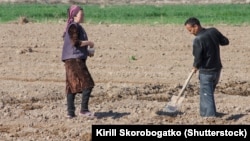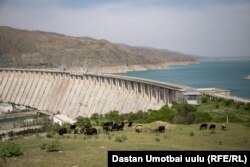It goes without saying that it's going to be scorching hot in Central Asia in June.
But this year, many places are setting new records for high temperatures and -- adding to the misery -- drought is setting in and taking a toll that can only be fully known in the coming weeks.
The upstream countries -- Kyrgyzstan and Tajikistan -- are facing difficulties with too little water and some want to keep more of it while the downstream countries -- namely Uzbekistan and Kazakhstan -- are seeking guarantees and offering deals for ample supplies of water to continue flowing.
Record Heat
June in Uzbekistan started with a warning from the State Meteorological Agency, Uzgidromet, that June 3-7 would see a drastic climb in heat with temperatures seven to 10 degrees hotter than usual.
The temperature in the capital, Tashkent, was 42.6 degrees Celsius on June 6, easily surpassing the previous highest temperature for that day, which was registered in 1811 when the temperature was 38.5 degrees Celsius.
The next day was slightly cooler at 40.8 degrees Celsius, still enough to top the previous record for that day that was set in 1894.
According to Uzgidromet, the hottest temperature ever recorded for Tashkent was on July 18, 1997, when thermometers reached 44.6 degrees Celsius.
On June 8, the director of Tajikistan’s meteorological center, Jamila Baydulloeva, told RFE/RL’s Tajik Service, known locally as Ozodi, that during the first week of June there were days when the thermometer hit 45 degrees Celsius in the capital, Dushanbe, and in the southern Khatlon region. It was the hottest temperature seen in early June in decades.
The capital of Turkmenistan, Ashgabat, was also experiencing temperatures of up to 45 degrees Celsius in June.
And summer is only beginning. Usually, July and August are the hottest months of the year.
The Drought
For several months it has been obvious Central Asia was heading into a period of severe drought.
The massive Toktogul Reservoir in Kyrgyzstan is a bellwether for 2021 in Central Asia.
Already in March, officials in Kyrgyzstan were warning the level of water in the reservoir was alarmingly low -- 8.7 billion cubic meters (bcm) -- well below the capacity of 19.5 bcm.
The reservoir takes water from the Naryn River, which itself eventually feeds into the Syr Darya, the longest river in Central Asia that brings essential water from its headstream in Tajikistan to Uzbekistan and Kazakhstan.
Toktogul is also the location of Kyrgyzstan’s largest hydropower plant (HHP), which supplies some 40 percent of the country’s electricity.
There has been talk in Kyrgyzstan about closing the floodgates and allowing the reservoir to replenish itself, though Kyrgyz Energy Minister Doskul Bekmurzaev said on June 16 that the water level had risen to 10.9 bcm.
Uzbekistan and Kazakhstan are obviously against the idea of closing the floodgates at Toktogul.
Both are negotiating electricity for water deals that would have Kyrgyzstan keep the water flowing from Toktogul and, in return, Kazakhstan and Uzbekistan would supply electricity to Kyrgyzstan to temporarily lessen its dependence on the Toktogul HHP for domestic power.
For Kazakhstan, the need for water in the Syr Darya is already clear.
The Kazakh meteorological agency is already forecasting severe drought for areas in six of the country’s 14 provinces: Aqmola, Aqtobe, East Kazakhstan, Mangistau, Kyzylorda, and Kustanay.
In Kyzylorda, which draws much of its water from the Syr Darya, local officials reduced the number of rice fields under cultivation this year, but the situation with fodder for livestock animals is grim and the heat is taking its toll on the animals.
The same is true further west, in Mangistau Province. Kazakh officials are already saying more than 2,000 animals, most of them horses, have died for lack of water and food in Kyzylorda and Mangistau provinces.
The situation is the same in the Yavan district of Tajikistan’s Khatlon region, where shepherd Abroriddin Haydarov told Ozodi there is almost no grass for his animals to graze on.
Kazakh officials are promising to bring in hay and water from other areas of the country and dig more wells in Mangistau, where a video posted by a local resident showed some farmers forced to feed their camels and horses with cardboard, and another of a horse being fed dirt.
The rush by Kazakhstan and Uzbekistan to procure hay for livestock is having an effect in Kyrgyzstan where the drought is just as severe in some areas.
The price of hay in Kyrgyzstan increased in the second week of June, for some by 50 percent.
Crop Failure
In Kyrgyzstan's Chui Province, some farmers are predicting a total loss of crops this year.
The lack of water coupled with aging canal systems badly in need of repair are leaving some fields dry.
Kyrgyz Agriculture Minister Almazbek Sokeev noted that water levels in many small reservoirs and rivers in the province are at less than half their normal amount, which perhaps led to him receiving a reprimand on June 14 .
Farmers in Chui Province met outside a government building in Bishkek on June 14, demanding state action be taken to save their crops.
Kyrgyz Prime Minister Ulukbek Maripov promised help for farmers.
“Despite the budget deficit, we are trying to pay for the damage,” Maripov said on June 17. But he also noted that Kyrgyzstan is strapped for cash and it is difficult to see where money will come from to compensate farmers, especially with a possible food crisis looming.
The drought is also devastating agriculture in Turkmenistan’s eastern Mary and Lebap provinces, with many of its farmers also predicting large-scale crop failures.
But Turkmen President Gurbanguly Berdymukhammedov once again predicted a successful harvest at a June 2 session of the government, calling on officials to ensure farmers are provided with all the seeds, fertilizer, modern equipment, and water that they need.
Farmers in the Karakum district of Mary Province told RFE/RL’s Turkmen Service, known locally as Azatlyk, that their cotton crops are already ruined.
“From the very beginning our fields were left without [enough] water and fertilizer and now, because of the fierce heat, the cotton plants that were just turning green have dried up,” said one farmer. “This is the first time we have seen so much cotton dry up.”
The local water reservoir has apparently fallen into total disrepair, and several farmers told Azatlyk that local officials seemed clueless about how to rectify the problem.
It is perhaps not surprising that farmers in Mary Province do not have water for their fields as a separate Azatlyk report said many areas in the capital, Ashgabat, are without water for most of the day in temperatures that sometimes reach 45 degrees Celsius.
The Turkmen government is often accused of gross mismanagement and, in what can only be described as its latest “own goal,” the government ordered famers in Mary Province’s village of Peshanay to burn the straw left over from the last wheat harvest.
Officials offered no reason for ordering farmers to destroy the straw, which many depend on to feed their farm animals. Officials also did not offer to provide farmers with other fodder for their animals.
The Consequences
Food prices are already rising sharply in many places across Central Asia.
The global coronavirus pandemic that hit the region early in 2020 crippled supply chains and this year’s drought in Central Asia guarantees food shortages in the months to come.
RFE/RL’s Current Time program aired a segment about the rising prices for fruits and vegetables in Kazakhstan and Kyrgyzstan.
Kazakh Trade Minister Bakhyt Sutanov is headed to Tashkent to talk about the export of Uzbek carrots and potatoes to Kazakhstan.
In Turkmenistan, the price of a kilogram of meat is 65 manats, or nearly $20 at the official rate, and five liters of cooking oil is 250 manats, slightly more than $70 at the official rate.
In eastern Tajikistan, people are also complaining that prices for basic food items in their less-developed, remote areas are on par with the prices for staples in shops in Moscow.
So far, good relations between the Central Asian governments are being maintained despite the problems and Uzbekistan in particular seems to be playing a key role in supplying neighbors with food, water, and electricity. It is, however, curious that the Uzbek media has not been reporting the same problems in Uzbekistan connected to drought that the country's neighbors are experiencing.
How long amicable ties between the five countries can be preserved under difficult circumstances is an important question, as is the patience of the people in those countries who seem to feel their governments should be doing more to help them.









